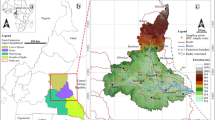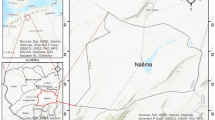Abstract
In India, persistent dependence on groundwater for intensively irrigated agriculture, industrial use and domestic activities imposes substantial threat to the quality and quantity of groundwater. This study assesses the suitability of groundwater for drinking purposes in parts of the Southern Gangetic Plain based on samples collected from 33 dug wells. In this scope, two robust indices are utilized, namely Groundwater Quality Index (GQI) and the Canadian Council of Ministers of the Environment (CCME) Water Quality Index (CCME_WQI), to assess the overall quality of groundwater by integrating observed water quality determinants like pH, TDS and major ion concentration. The concentration of major anions and cations is observed to be in the order of HCO3 − > Cl− > SO4 2− > NO3 − and Na+ > Ca2+ > Mg2+ > K+, respectively. The pH values of the analyzed samples vary between 6.2 and 7.37 during the post-monsoon (POM) period and between 6.6 and 7.9 during the pre-monsoon (PRM) period. Similarly, TDS concentrations are observed to vary between 6.7 and 1535 mg/l (POM) and 1.43 and 1327 mg/l (PRM). The values of GQI in the study area range between 10.41–108.56 and 16.03–130.06 for the PRM and POM periods, respectively. Among the groundwater samples collected during the PRM period, about 21, 73 and 6% are found to be excellent, good and poor quality, respectively. While the percentage of poor quality water for POM period is exactly the same as that of PRM, about 42 (52%) of the samples are found to be of excellent (good) quality for drinking purposes. The analysis of CCME_WQI for groundwater samples reveals that 3 (21%), 42 (36%), 33 (18%), 21 (24%) of the samples collected during PRM (POM) are classified to be of excellent, good, fair and marginal category, respectively. The spatial distribution of GQI and CCME_WQI illustrates that excellent quality water occurs primarily in the northeast part of the study area during the POM period. However, some localized patches with excellent quality are also observed in both the seasons. Results from this study will be crucial for proper utilization and management of already depleted groundwater resources of the study area.









Similar content being viewed by others
References
APHA (1995) Standard methods for the examination of water and wastewater, 19th edn. American Public Health Association, New York
Bahar MM, Reza MS (2009) Hydrochemical characteristics and quality assessment of shallow groundwater in a coastal area of Southwest Bangladesh. Environ Earth Sci. doi:10.1007/s12665-009-0427-4
BIS (2003) Indian standards, drinking water specifications (1st revision, amendment no. 2). Bureau of Indian Standards, New Delhi
CCME (2001) Canadian water quality guidelines for the protection of aquatic life. CCME Water Quality Index 1.0
Chae G, Kim K, Yun S, Kim S, Choi B, Kim H, Rhee CW (2004) Hydrogeochemistry of alluvial groundwater in an agricultural area: an implication for groundwater contamination susceptibility. Chemosphere 55:369–378
Chakroborty C, Chattopadhyay GS (2001) Quaternary geology of South Ganga Bihar. Indian Miner 55:133–142
Cloutier V, Lefebvre R, Therrien R, Savard MM (2008) Multivariate statistical analysis of geochemical data as indicative of the hydrogeochemical evolution of groundwater in a sedimentary rock aquifer system. J Hydrol 353:294–313
Das BK, Kaur P (2007) Geochemistry of surface and subsurface waters of Rewalsar Lake, Mandi district, Himachal Pradesh, constraints on weathering and erosion. J Geol Soc India 69(5):1020–1030
De P (1986) Quarternary geology and geomorphology of Son-Ganga Basin, Nalanda District, Bihar. Unpublished Report, Geological Survey of India, p 8
Debels P, Figueroa R, Urrutia R, Barra R, Niell X (2005) Evaluation of water quality in the Chillan River (Central Chile) using physicochemical parameters and a modified water quality index. Environ Monit Assess 110:301–322
Dimitriou E, Moussoulis E (2011) Land use change scenarios and associated groundwater impacts in a protected peri-urban area. Environ Earth Sci 64:471–482
Gowd S (2005) Assessment of groundwater quality for drinking and irrigation purposes: a case study of Peddavanka watershed, Anantapur District, Andhra Pradesh, India. Environ Geol 48:702–712
Humphreys WF (2009) Hydrogeology and groundwater ecology. J Hydrol 17(1):5–21
Ketata-Rokbani M, Gueddari M, Bouhlila R (2011) Use of geographical information system and water quality index to access groundwater quality in EI Khairat Deep aquifer (Enfidha, Tunsian Sahel). Iran J Energy Environ 2(2):133–144
Khan F, Husain T, Lumb A (2003) Water quality evaluation and trend analysis in selected watersheds of the Atlantic Region of Canada. Environ Monit Assess 88:221–242
Khan HH, Khan A, Ahmed S, Perrin J (2011) GIS-based impact assessment of land-use changes on groundwater quality, study from a rapidly urbanizing region of South India. Environ Earth Sci 63:1289–1302
Kumar M, Kumari K, Ramanathan AL, Saxena R (2007) A comparative evaluation of groundwater suitability for irrigation and drinking purposes in two intensively cultivated districts of Punjab, India. Environ Geol 5:553–574
Lakshamanan E, Kannan R, Senthil KM (2003) Major ion chemistry and identification of hydrogeochemical processes of groundwater in a part of Kancheepuram district, Tamil Nadu, India. Environ Geosci 10(4):157–166
Machiwal D, Jha MK, Mal BC (2011) GIS-based assessment and characterization of groundwater quality in a hard-rock hilly terrain of Western India. Environ Monit Assess 174:645–663. doi:10.1007/s10661-010-1485-5
Magesh NS, Krishnakumar S, Chandrasekar N, Soundranayagam JP (2012) Groundwater quality assessment using WQI and GIS techniques, Dindigul District, Tamil Nadu, India. Geosci, Arab J. doi:10.1007/s12517-012-0673-8
Nas B, Berktay A (2008) Groundwater quality mapping in urban groundwater using GIS. Environ Monit Assess 160:215–227
Prasad RK, Mondal NC, Singh VS (2008) Evaluation of groundwater resource potential using GIS in Kurmapalli watershed of Andhra Pradesh. J Geol Soc India 71(5):661–669
Rahman A (2008) A GIS based drastic model for assessing groundwater vulnerability in shallow aquifer in Aligarh, India. Appl Geogr 28:32–53
Rajesh R, Sreedhara MTR, Raghavan BR (2002) The utility of multivariate statistical techniques in hydrogeochemical studies: an example from Karnataka, India. Water Res 36:2437–2442
Ramakrishnaiah CR, Sadashivaiah C, Ranganna G (2009) Assessment of water quality index for the groundwater in Tumkur Taluk, Karnataka State, India. J Chem 6(2):523–530
Rao SN, Prakasa-Rao J, John DD, Srinivasa-Rao K, Krishna C (2001) Multivariate analysis for identifying the governing factors of groundwater quality. J Environ Hydrol 9(16):1–9
Reddy AGS, Saibaba B, Sudarsan G (2012) Hydrogeochemical characterization of contaminated groundwater in Patancheru industrial area, Southern India. Environ Monit Assess 184(6):3557–3576
Sadat-Noori SM, Ebrahimi K, Liaghat AM (2013) Groundwater quality assessment using water quality index and GIS in Saveh-Nobaran aquifer, Iran. Environ Earth Sci. doi:10.1007/s12665-013-2770-8
Saeedi M, Abessi O, Sharifi F, Meraji H (2010) Development of groundwater quality index. Environ Monit Assess. doi:10.1007/s10661-009-0837-5
Saha D, Upadhyay S, Dhar YR, Singh R (2007) The aquifer system and evaluation of its hydraulic parameters in parts of South Ganga Plain, Bihar, India. J Geol Soc Ind 69:1031–1041
Sahu P, Sikdar PK (2008) Hydrochemical framework of the aquifer in and around East Kolkata wetlands, West Bengal India. Environ Geol 55:823–835
Sargaonkar A, Deshpande V (2003) Development of an overall index of pollution for surface water based on a general classification scheme in Indian context. Environ Monit Asses 89:43–67
Selvam S, Manimaran G, Sivasubramanian P, Balasubramanian N, Seshunarayana T (2013) GIS-based evaluation of water quality index of groundwater resources around Tuticorin coastal city, South India. Environ Earth Sci. doi:10.1007/s12665-013-2662-y
Sethy SN, Syed TH, Kumar A, Sinha D (2016) Hydrogeochemical characterization and quality assessment of groundwater in parts of southern Gangetic Plain. Environ Earth Sci. doi:10.1007/s12665-015-5049-4
Shirazi SM, Imran HM, Akib S (2012) GIS-based DRASTIC method for groundwater vulnerability assessment: a review. J Risk Res 15(8):991–1011
Singaraja C, Chidambaram S, Prasanna MV, Thivya C, Thilagavathi R (2013) Statistical analysis of the hydrogeochemical evolution of groundwater in hard rock coastal aquifers of Thoothukudi district in Tamil Nadu, India. Environ Earth Sci. doi:10.1007/s12665-013-2453-5
Singh AK, Mondal GC, Singh PK, Singh S, Singh TB, Tewary BK (2005) Hydrochemistry of reservoirs of Damodar River basin, India: weathering processes and water quality assessment. Environ Geol 48:1014–1028
Singh AK, Mondal GC, Kumar S, Singh TB, Tewary BK, Sinha A (2008) Major ion chemistry, weathering processes and water quality assessment in upper catchment of Damodar River basin, India. Environ Geol 54:745–758
Singh K, Singh D, Hundal HS, Khurana MPS (2013) An appraisal of groundwater quality for drinking and irrigation purposes in southern part of Bathinda district of Punjab, northwest India. Environ Earth Sci. doi:10.1007/s12665-013-2272-8
Sophiya MS, Syed TH (2013) Assessment of vulnerability to seawater intrusion and potential remediation measures for coastal aquifer: a case study from eastern India. Environ Earth Sci 70(3):1197–1209
Srinivasamoorthy K, Chidambaram M, Prasanna MV, Vasanthavigar M, John PA, Anandhan P (2008) Identification of major sources controlling groundwater chemistry from a hard rock terrain: a case study from Mettur taluk, Salem district, Tamil Nadu, India. J Earth Syst Sci 117(1):49–58
Srivastava A (2005) Aquifer geometry, basement-topography and groundwater quality around Ken Graben, India. J Spat Hydrol 2(2):1–7
Steube C, Richter S, Griebler C (2009) First attempts towards an integrative concept for the ecological assessment of groundwater ecosystems. J Hydrol 17(1):23–35
Subramani T, Elango L, Damodarasamy SR (2005) Groundwater quality and its suitability for drinking and agricultural use in Chithar River Basin, Tamil Nadu, India. Environ Geol 47:1099–1110
Thapinta A, Hudak P (2003) Use of geographic information systems for assessing groundwater pollution potential by pesticides in Central Thailand. Int Environ 29:87–93
Tiwari TN, Mishra MA (1985) A preliminary assignment of water quality index of major Indian rivers. Indian J Environ Prot 5:276–279
U.S. Environmental Protection Agency (USEPA) (2007) Dallas, TX (2000–05). Chapter 3: exposure scenario selection. Retrieved 2 Feb 2007. RCRA Delisting Technical Support Document, p 8
Vasanthavigar M, Srinivasamoorthy K, Vijayaragavan K, Rajiv GR, Chidambaram S, Anandhan P, Manivannan R, Vasudevan S (2010) Application of water quality index for groundwater quality assessment: Thirumanimuttar sub-basin, Tamilnadu, India. Environ Monit Assess 171:595–609
Vijay R, Khobragade P, Mohapatra PK (2011) Assessment of groundwater quality in Puri City, India; an impact of anthropogenic activities. Environ Monit Assess 177(1):409–418
WHO (2011) Guidelines for drinking water quality recommendations, 3rd edn. World Health Organisation, Geneva
Acknowledgements
The Junior Research Fellow grant of the Indian Institute of Technology (ISM), Dhanbad has sponsored a part of this research. The authors are very grateful to Dr. Dipankar Saha, regional director of Central Ground Water Board (CGWB) Patna, for his help. The authors are also thankful to Dr. Sagar Pal (Department of Applied Chemistry) and T. Sinha (Department of Environmental Science and Engineering) for providing access to laboratory facilities for water quality analysis.
Author information
Authors and Affiliations
Corresponding author
Rights and permissions
About this article
Cite this article
Sethy, S.N., Syed, T.H. & Kumar, A. Evaluation of groundwater quality in parts of the Southern Gangetic Plain using water quality indices. Environ Earth Sci 76, 116 (2017). https://doi.org/10.1007/s12665-017-6434-y
Received:
Accepted:
Published:
DOI: https://doi.org/10.1007/s12665-017-6434-y




